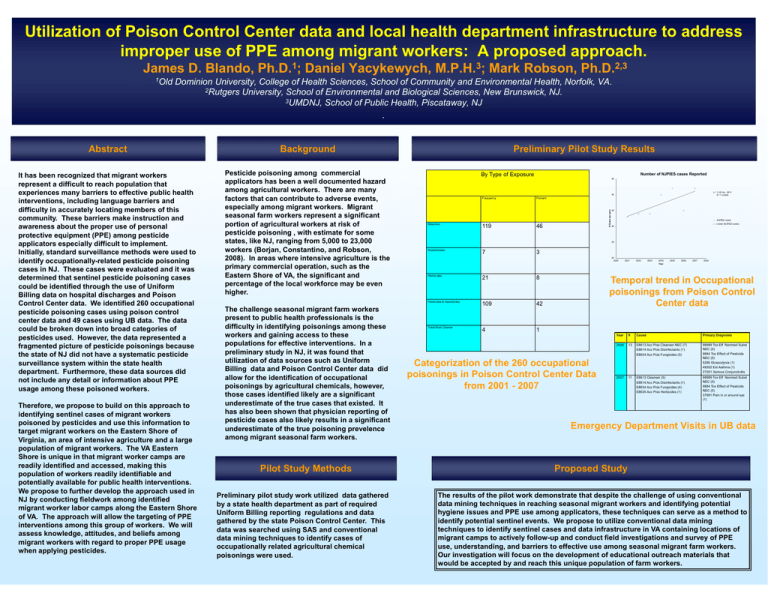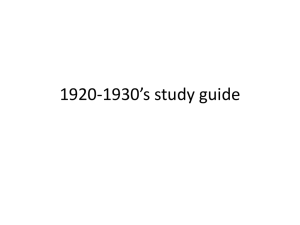Utilization of Poison Control Center data and local health department... improper use of PPE among migrant workers: A proposed...
advertisement

Utilization of Poison Control Center data and local health department infrastructure to address improper use of PPE among migrant workers: A proposed approach. James D. Blando, Ph.D.1; Daniel Yacykewych, M.P.H.3; Mark Robson, Ph.D.2,3 Dominion University, College of Health Sciences, School of Community and Environmental Health, Norfolk, VA. 2Rutgers University, School of Environmental and Biological Sciences, New Brunswick, NJ. 3UMDNJ, School of Public Health, Piscataway, NJ . Abstract Background It has been recognized that migrant workers represent a difficult to reach population that experiences many barriers to effective public health interventions, including language barriers and difficulty in accurately locating members of this community. These barriers make instruction and awareness about the proper use of personal protective equipment (PPE) among pesticide applicators especially difficult to implement. Initially, standard surveillance methods were used to identify occupationally-related pesticide poisoning cases in NJ. These cases were evaluated and it was determined that sentinel pesticide poisoning cases could be identified through the use of Uniform Billing data on hospital discharges and Poison Control Center data. We identified 260 occupational pesticide poisoning cases using poison control center data and 49 cases using UB data. The data could be broken down into broad categories of pesticides used. However, the data represented a fragmented picture of pesticide poisonings because the state of NJ did not have a systematic pesticide surveillance system within the state health department. Furthermore, these data sources did not include any detail or information about PPE usage among these poisoned workers. Pesticide poisoning among commercial applicators has been a well documented hazard among agricultural workers. There are many factors that can contribute to adverse events, especially among migrant workers. Migrant seasonal farm workers represent a significant portion of agricultural workers at risk of pesticide poisoning , with estimate for some states, like NJ, ranging from 5,000 to 23,000 workers (Borjan, Constantino, and Robson, 2008). In areas where intensive agriculture is the primary commercial operation, such as the Eastern Shore of VA, the significant and percentage of the local workforce may be even higher. Therefore, we propose to build on this approach to identifying sentinel cases of migrant workers poisoned by pesticides and use this information to target migrant workers on the Eastern Shore of Virginia, an area of intensive agriculture and a large population of migrant workers. The VA Eastern Shore is unique in that migrant worker camps are readily identified and accessed, making this population of workers readily identifiable and potentially available for public health interventions. We propose to further develop the approach used in NJ by conducting fieldwork among identified migrant worker labor camps along the Eastern Shore of VA. The approach will allow the targeting of PPE interventions among this group of workers. We will assess knowledge, attitudes, and beliefs among migrant workers with regard to proper PPE usage when applying pesticides. The challenge seasonal migrant farm workers present to public health professionals is the difficulty in identifying poisonings among these workers and gaining access to these populations for effective interventions. In a preliminary study in NJ, it was found that utilization of data sources such as Uniform Billing data and Poison Control Center data did allow for the identification of occupational poisonings by agricultural chemicals, however, those cases identified likely are a significant underestimate of the true cases that existed. It has also been shown that physician reporting of pesticide cases also likely results in a significant underestimate of the true poisoning prevelence among migrant seasonal farm workers. Pilot Study Methods Preliminary pilot study work utilized data gathered by a state health department as part of required Uniform Billing reporting regulations and data gathered by the state Poison Control Center. This data was searched using SAS and conventional data mining techniques to identify cases of occupationally related agricultural chemical poisonings were used. Preliminary Pilot Study Results By Type of Exposure Number of NJPIES cases Reported 45 y = 1.3214x - 2611 R² = 0.5048 40 Frequency Percent Bleaches 119 46 Rodenticides 7 3 # Cases per year 1Old 35 NJPIES cases Linear (NJPIES cases) 30 25 20 2000 Herbicides 21 8 Pesticides & Insecticides 109 42 Toilet Bowl Cleaner 4 1 2001 2002 2003 2004 Year 2005 2006 2007 2008 Temporal trend in Occupational poisonings from Poison Control Center data Categorization of the 260 occupational poisonings in Poison Control Center Data from 2001 - 2007 Year # Cause Primary Diagnosis 2006 13 E8613 Acc Pois Cleanser NEC (7) E8614 Acc Pois Disinfectants (1) E8634 Acc Pois Fungicides (5) 98989 Tox Eff Nonmed Subst NEC (5) 9894 Tox Effect of Pesticide NEC (5) 5296 Glossodynia (1) 49302 Ext Asthma (1) 37201 Serious Conjunctivitis 2007 11 E8613 Cleanser (5) E8614 Acc Pois Disinfectants (1) E8634 Acc Pois Fungicides (4) E8635 Acc Pois Herbicides (1) 98989 Tox Eff Nonmed Subst NEC (5) 9894 Tox Effect of Pesticide NEC (5) 37991 Pain in or around eye (1) Emergency Department Visits in UB data Proposed Study The results of the pilot work demonstrate that despite the challenge of using conventional data mining techniques in reaching seasonal migrant workers and identifying potential hygiene issues and PPE use among applicators, these techniques can serve as a method to identify potential sentinel events. We propose to utilize conventional data mining techniques to identify sentinel cases and data infrastructure in VA containing locations of migrant camps to actively follow-up and conduct field investigations and survey of PPE use, understanding, and barriers to effective use among seasonal migrant farm workers. Our investigation will focus on the development of educational outreach materials that would be accepted by and reach this unique population of farm workers.



